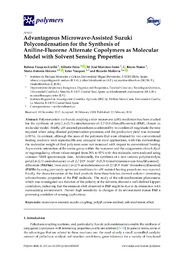Por favor, use este identificador para citar o enlazar este ítem:
https://hdl.handle.net/11000/5259Registro completo de metadatos
| Campo DC | Valor | Lengua/Idioma |
|---|---|---|
| dc.contributor.author | Vázquez Guilló, Rebeca | - |
| dc.contributor.author | Falcó Graciá, Juan Alberto | - |
| dc.contributor.author | Martínez Tomé, M. José | - |
| dc.contributor.author | Mateo, C. Reyes | - |
| dc.contributor.author | Herrero, María Antonia | - |
| dc.contributor.author | Vázquez, Ester | - |
| dc.contributor.author | Mallavia Marín, Ricardo | - |
| dc.contributor.other | Departamentos de la UMH::Agroquímica y Medio Ambiente | es |
| dc.date.accessioned | 2019-09-05T09:03:22Z | - |
| dc.date.available | 2019-09-05T09:03:22Z | - |
| dc.date.created | 2018-02-20 | - |
| dc.date.issued | 2019-09-05 | - |
| dc.identifier.issn | 2073-4360 | - |
| dc.identifier.uri | http://hdl.handle.net/11000/5259 | - |
| dc.description.abstract | Polymerization via Suzuki coupling under microwave (_W) irradiation has been studied for the synthesis of poly{1,4-(2/3-aminobenzene)-alt-2,7-(9,9-dihexylfluorene)} (PAF), chosen as molecular model. Briefly, _W-assisted procedures accelerated by two orders of magnitude the time required when using classical polymerization processes, and the production yield was increased (>95%). In contrast, although the sizes of the polymers that were obtained by non-conventional heating reactions were reproducible and adequate for most applications, with this methodology the molecular weight of final polymers were not increased with respect to conventional heating. Asymmetric orientation of the amine group within the monomer and the assignments of each dyad or regioregularity, whose values ranged from 38% to 95% with this molecule, were analysed using common NMR spectroscopic data. Additionally, the synthesis of a new cationic polyelectrolyte, poly{1,4-(2/3-aminobenzene)-co-alt-2,7-[9,9´-bis(6”-N,N,N-trimethylammonium-hexyl)fluorene]} dibromide (PAFAm), from poly{1,4-(2/3-aminobenzene)-co-alt-2,7-[9,9´-bis(6”-bromohexyl)fluorene]} (PAFBr) by using previously optimized conditions for _W-assisted heating procedures was reported. Finally, the characterization of the final products from these batches showed unkown interesting solvatochromic properties of the PAF molecule. The study of the solvatochromism phenomena, which was investigated as a function of the polarity of the solvents, showed a well-defined Lippert correlation, indicating that the emission shift observed in PAF might be due to its interaction with surrounding environment. Proven high sensitivity to changes of its environment makes PAF a promising candidate of sensing applications. | es |
| dc.description.sponsorship | This work was supported by the Spanish Ministerio de Economía y Competitividad research projects MAT-2017-86805-R, MAT-2014-53282-R, CTQ2014-53600-R and CTQ2016-76721-R | - |
| dc.description.sponsorship | We also thank the Spanish Ministerio de Educación for the Mobility Fellowship BES-2012-051900. | - |
| dc.format | application/pdf | es |
| dc.format.extent | 15 | es |
| dc.language.iso | eng | es |
| dc.rights | info:eu-repo/semantics/openAccess | es |
| dc.subject | microwave-assisted | es |
| dc.subject | suzuki coupling | es |
| dc.subject | poly(fluorene-aniline | es |
| dc.subject | solvatochromic effect | es |
| dc.title | Advantageous Microwave-Assisted Suzuki Polycondensation for the Synthesis of Aniline-Fluorene Alternate Copolymers as Molecular Model with Solvent Sensing Properties | es |
| dc.type | info:eu-repo/semantics/article | es |
| dc.identifier.doi | 10.3390/polym10020215 | - |
| dc.relation.publisherversion | http://dx.doi.org/10.3390/polym10020215 | - |

Ver/Abrir:
2-polymers-10-00215-v2.pdf
952,55 kB
Adobe PDF
Compartir:
 La licencia se describe como: Atribución-NonComercial-NoDerivada 4.0 Internacional.
La licencia se describe como: Atribución-NonComercial-NoDerivada 4.0 Internacional.
.png)